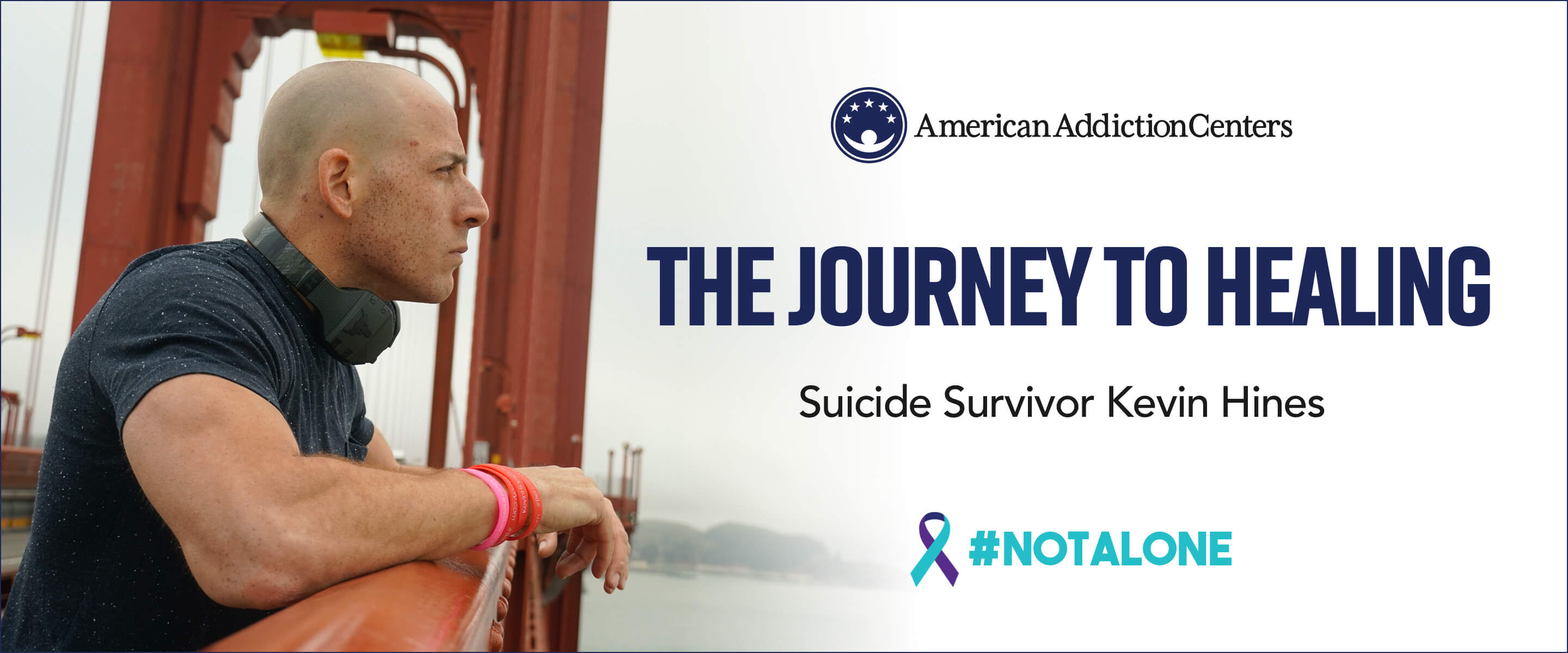
National Suicide Prevention Awareness Month
#NotAlone

In recognition of National Suicide Prevention Awareness Month, American Addiction Centers has partnered with Kevin Hines, a suicide survivor and prominent suicide prevention activist.
Suicide is the 10th leading cause of death and third leading cause of death for people ages 15 – 19. On average, more than 130 people die by suicide each day and approximately 1.4 Americans attempt suicide each year. Suicide is a public health issue that affects more than half of the country, but misinformation and a lack of understanding has stigmatized the topic. Research has shown that the stigma surrounding mental health and suicide decreases self-esteem, increases social isolation and discourages people from reaching out to anyone for help.
Kevin’s Story
Early childhood trauma and untreated mental health conditions were significant contributing factors that led to Kevin’s suicide attempt. Despite being adopted by loving parents and having a great childhood, he endured immense emotional pain and kept it from others. With the belief that no one cared about him, Kevin’s troubles culminated on September 25, 2000, when he attempted to take his own life by jumping from the Golden Gate Bridge.
Kevin is among the 1% of people who have survived that attempt, and has been an outspoken advocate for suicide prevention awareness ever since. He has created a foundation, the Kevin and Margaret Hines Foundation, focused on mental wellness and education, and also has an informative YouTube channel where he further expands on his life and experiences.
The Early Years: Addiction in the Family
Events and experiences that occur during childhood are powerful determinants of the adult the individual becomes. The time from the prenatal period to late adolescence is when the foundation for adult relationships, health and social outcomes and behaviors are developed.
Adverse childhood events, or ACEs, have repercussions that can last a lifetime. The prolonged stress that children endure in adverse conditions can negatively affect their decision-making skills, behavior and emotions. Children in these environments are also at an increased risk of using alcohol and/or drugs, experiencing mental health challenges and engaging in health-risk behaviors such as suicide attempts. In fact, adverse childhood experiences of any kind increase the risk of attempted suicide two to five-fold.
Facing Mental Health Challenges
Kevin was diagnosed with bipolar disorder when he was 17 years old. He struggled with accepting his diagnosis, which ultimately led him down a dark path to suicide. According to the National Alliance on Mental Illness, one in five adults experience mental illness each year and half of all lifetime mental illness begins by age 14.
Surviving Suicide: Another Chance at Life
Suicide impacts millions – nearly 45,000 lives are lost each year and countless more are affected. The story of Kevin’s attempt provides some perspective.
Studies show that 9 out of 10 people who attempt suicide and survive will not die by suicide at a later date, figures that researchers suggest are consistent with the determination that a significant number of suicidal crises are short-lived. This is similar in nature to the feelings that Kevin expressed, that he immediately regretted his attempt, it was the biggest mistake of his life and that he did not want to die. Interestingly, a 1975 study of 515 people whose attempt to jump off the Golden Gate Bridge between 1937 and 1971 found that after 26 years, 94% were alive.
Hope in the Face of Adversity
September 25 is the 20th anniversary of Kevin’s attempt. Though he is now two decades removed from that fateful day, his mental heath is something he has worked on every day since.
Kevin, like many other people who have a mental health condition, knows that an equally important component of daily mental health care is a supportive community or network of people who care. The stigma of suicide very often prevents those struggling from reaching out for help, so if you suspect someone is struggling, ask them. Numerous studies have suggested that asking about suicide diminished suicidal ideation. Other methods of support include being present for that person to limit the amount of isolation that they feel, helping them connect to available resources, and, once they’ve received care, check in with them. Following up creates a feeling of connectedness that research has suggested prevents suicide.
As Kevin says, “Suicide never has to be the solution to your problems.”
If you or someone you know is struggling with suicidal thoughts, contact the National Suicide Prevention Lifeline at 1-800-273-TALK (8255).
American Addiction Centers specializes in treating substance use disorder and co-occurring mental health conditions. Take the first step and find out if your insurance covers treatment. AAC is in-network with many insurance companies.